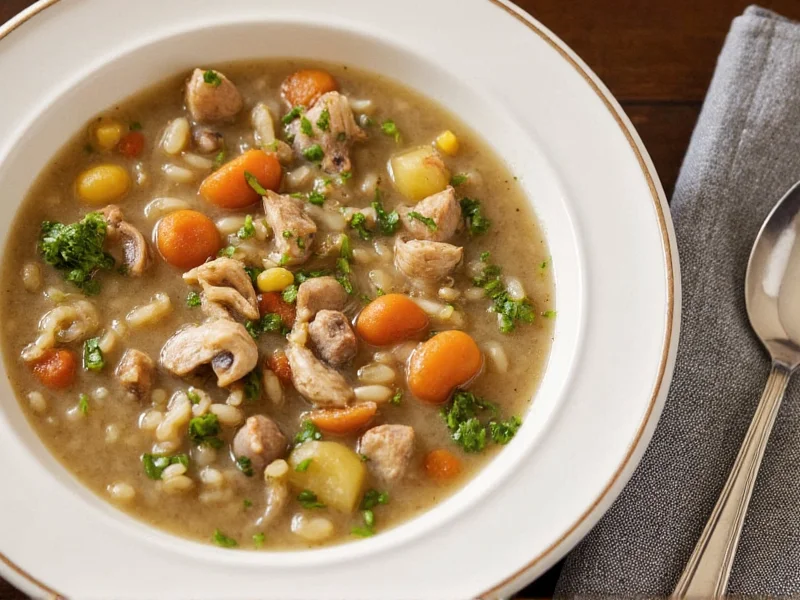Creating an exceptional chicken mushroom wild rice soup requires understanding the delicate balance between ingredients and technique. Unlike instant versions, the authentic preparation method develops deep flavors through proper sautéing, controlled simmering, and strategic ingredient timing. This guide provides professional insights you won't find in basic recipes, helping you master this beloved comfort food.
The Essential Components of Authentic Chicken Mushroom Wild Rice Soup
What separates a mediocre soup from a memorable one lies in ingredient selection and preparation methodology. Wild rice isn't actually rice but a grass seed with distinctive chewiness and earthy flavor that holds up well during cooking. Combining it with cultivated mushrooms creates a complex umami profile that elevates the entire dish.
| Ingredient Category | Recommended Options | Why It Matters |
|---|---|---|
| Chicken | Bone-in thighs (skin-on), breast meat added later | Bones add collagen for richer texture; thighs stay moist during simmering |
| Wild Rice Blend | True wild rice mixed with cultivated varieties (20-30% wild) | Pure wild rice takes 45-60 minutes; blends cook faster while maintaining texture |
| Mushrooms | Cremini (base), shiitake (umami boost), porcini powder (depth) | Diverse mushroom varieties create layered flavor impossible with single type |
| Aromatics | Leeks (instead of onions), celery root, fresh thyme | Leeks provide milder sweetness; celery root adds earthiness without stringiness |
Professional Technique: Beyond Basic Recipe Instructions
Most recipes miss critical technique details that determine success. The professional approach involves three distinct cooking phases:
Phase 1: Building Flavor Foundations
Start by rendering chicken skin to extract fat for sautéing. Reserve crispy skin bits for garnish. Sauté mushrooms separately until deeply browned—this Maillard reaction creates hundreds of flavor compounds. Never crowd the pan; cook mushrooms in batches to prevent steaming. Deglaze with dry sherry before adding aromatics.
Phase 2: Strategic Simmering
Add wild rice to the broth after initial flavor development. True wild rice requires 45-60 minutes, but adding it too early with chicken leads to overcooked poultry. Instead, simmer chicken bones first for 30 minutes, remove chicken, add rice, then return shredded meat during the last 10 minutes. This prevents dry, stringy chicken.
Phase 3: Final Flavor Integration
Finish with a "mounting" technique: remove soup from heat, stir in cold butter pieces to emulsify and create velvety texture. Add lemon zest and fresh herbs just before serving to preserve bright flavors. Let soup rest 15 minutes before serving—this allows flavors to harmonize and rice to absorb optimal liquid.
Avoiding Common Preparation Mistakes
Even experienced cooks make these critical errors:
- Using only white mushrooms—creates one-dimensional flavor. Combine at least three varieties for complexity.
- Adding all ingredients simultaneously—different components require different cooking times for optimal texture.
- Overcooking wild rice—should retain slight chewiness, not become mushy. Test 10 minutes before package instructions suggest.
- Skipping the resting period—soup flavors need time to integrate; serving immediately yields disjointed taste.
Dietary Adaptations Without Sacrificing Flavor
Professional kitchens accommodate dietary needs while maintaining quality:
Gluten-free preparation: Use cornstarch slurry instead of flour for thickening. Combine 1 tablespoon cornstarch with 2 tablespoons cold broth, whisk into simmering soup.
Dairy-free version: Replace butter with high-quality olive oil during finishing. Add 1/4 cup unsweetened cashew cream for similar richness.
Lower-sodium option: Use mushroom soaking liquid as 25% of broth. Dried mushrooms contain natural glutamates that enhance savory perception without salt.
Storage and Reheating for Maximum Flavor Retention
Proper storage actually improves wild rice soup. The rice continues absorbing liquid, so store with 1/2 cup extra broth. Refrigerate for up to 4 days or freeze for 3 months. When reheating:
- Thaw frozen soup overnight in refrigerator
- Reheat gently over medium-low heat (do not boil)
- Add splash of broth if too thick
- Stir in fresh herbs and lemon zest after heating
Many chefs note that wild rice soup tastes better on day two as flavors fully integrate. The wild rice also achieves ideal texture after refrigeration and reheating.
Frequently Asked Questions
Can I use only wild rice instead of a blend?
Yes, but expect longer cooking time (45-60 minutes) and more liquid absorption. True wild rice expands 2-3 times its original size and requires additional broth during cooking. A blend with cultivated rice provides more consistent texture for beginners.
Why does my wild rice become mushy?
Mushy wild rice typically results from overcooking or using too much liquid. Wild rice should maintain slight chewiness. Use a 3:1 liquid-to-rice ratio and check texture 10 minutes before package instructions suggest. Remember that residual heat continues cooking the rice after removal from stove.
How can I deepen the mushroom flavor without adding more mushrooms?
Soak dried porcini mushrooms in hot water for 20 minutes, then use this liquid as 25% of your broth. The soaking liquid contains concentrated umami compounds. Alternatively, add 1 teaspoon mushroom powder during the sauté phase for intensified earthy notes without altering texture.
What's the best way to prevent chicken from drying out?
Use bone-in, skin-on thighs for the initial simmer (30 minutes), then remove and shred. Add breast meat or shredded thigh meat during the last 10 minutes of cooking. The dark meat withstands longer cooking while breast meat needs minimal heat exposure to remain tender.
Can I make this soup in a slow cooker?
Yes, but with technique adjustments. Sauté mushrooms and aromatics first, then transfer to slow cooker with broth and bones. Cook on low 4 hours, remove bones/chicken, add wild rice, cook 1 more hour, then add shredded chicken and finish with butter off-heat. Avoid cooking wild rice the entire time or it will become mushy.











 浙公网安备
33010002000092号
浙公网安备
33010002000092号 浙B2-20120091-4
浙B2-20120091-4